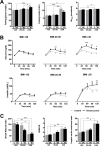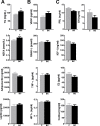Breast cancer is associated to impaired glucose/insulin homeostasis in premenopausal obese/overweight patients
- PMID: 29113405
- PMCID: PMC5655300
- DOI: 10.18632/oncotarget.20399
Breast cancer is associated to impaired glucose/insulin homeostasis in premenopausal obese/overweight patients
Abstract
The association between breast cancer (BCa) presence and altered glucose/insulin metabolism is controversial likely due to an inaccurate insulin resistance (IR) assessment and inappropriate stratification of patients by body-mass index (BMI) and menopausal state. 148 women with suspect of sporadic BCa were stratified by BMI and menopause. Fasting levels of glucose, insulin, glycohemoglobin and selected IR-related and tumor-derived markers were measured. Glucose/insulin levels during OGTT were used to calculate insulin resistance/sensitivity indexes. Analysis of 77 BCa-bearing patients and 71 controls showed an association between BCa and IR as demonstrated by impaired glucose/insulin homeostasis (increased fasting- and OGTT-induced glucose levels) and deteriorated IR indexes, which was especially patent in premenopausal women. The association between BCa presence and IR was markedly influenced by BMI, being obese BCa patients significantly more insulin resistant than controls. BCa presence was associated to elevated levels of IR (glucose, triglycerides) and tumor-derived (VEGF) markers, especially in overweight/obese patients. BCa presence is associated to IR in overweight/obese premenopausal but not in premenopausal normal weight or postmenopausal women. Our data support a bidirectional relationship between dysregulated/imbalanced glucose/insulin metabolism and BCa, as tumor- and IR-markers are correlated with the impairment of glucose/insulin metabolism in overweight/obese premenopausal BCa patients.
Keywords: OGTT; breast cancer; glucose; insulin; obesity.
Conflict of interest statement
CONFLICTS OF INTEREST The authors declare that they have no conflicts of interest.
Figures





References
-
- Siegel RL, Miller KD, Jemal A. Cancer Statistics, 2017. CA Cancer J Clin. 2017;67:7–30. - PubMed
-
- Jiralespong S, Goodwin P. Obesity and breast cancer prognosis: evidence, challenges, and opportunities. J Clin Oncol. 2016;34:4203–16. - PubMed
-
- Goodwin PJ. Obesity, insulin resistance and breast cancer outcomes. Breast. 2015;24:S56–S9. - PubMed
-
- Donohoe CL, Lysaght J, O’Sullivan J, Reynolds JV. Emerging concepts linking obesity with the hallmarks of cancer. Trends Endocrinol Metab. 2017;28:46–62. - PubMed
LinkOut - more resources
Full Text Sources
Other Literature Sources

